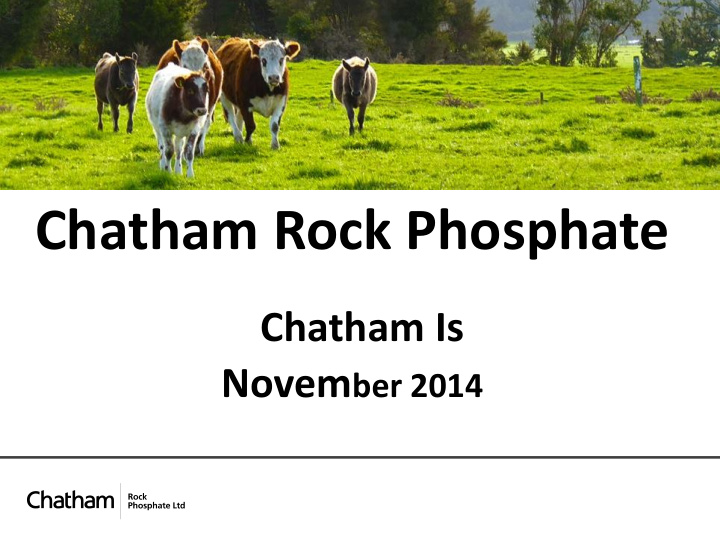



Chatham Rock Phosphate Chatham Is Novem ber 2014
Overview Benefits to NZ and Chatham Is Mining method Key effects and mitigation Sustainable management of NZ’s natural resources
Mining permit area - 250 km from Chatham Is. 450 km from NZ
Marine consent area reduced
Benefits for NZ Only major NZ rock phosphate deposit Replace some of the 1m tonne imports – mostly from Morocco/Western Sahara $900m value to NZ – (NZIER) Import substitution & exports - $250m annually Environmental benefits of end product – low cadmium & direct application means less nutrient run-off to water New industry – undersea mining
Chatham Is benefits Environmental Compensation Trust - $350,000 a year. Focus on Chatham Rise, where impacts are Chatham Is Trust - $280,000 a year: Enhance farming (could include fertiliser) Enhance economic development opportunities Educational and cultural support Other community activities Local involvement on trusts to decide how money spent 6
Chatham Is benefits continued CRP will support local efforts for share of Government royalty 2 % of turnover or 10 % of pre-tax profit Committed to buying/using Chatham Is input as much as possible – e.g. monitoring, staff on ship Environmental Reference Group – island representation Want ideas 7
Mining method Boskalis is the technology partner Existing technology with flexible connections
Mining plan and effects Mine 30 km 2 a year in waters 350-450m Total 450 km 2 over 15 years (0.5% of Chatham Rise shallower than 1000m) 1050 km 2 mining exclusion area (1/5 th of consent area) Minimal impacts on spawning or juvenile fish habitat Effects confined to a few km Will remove organisms in mining area. Sedimentation will affect organisms alongside mining blocks 9
Sediment plume Modelling shows sediment will be contained to small area and will dissipate within a few days All experts agreed: Sediment model is appropriate and conservative If the amount of fine material doubled, the plume would still be within the bounds of original plots
Benthic communities and coral Unavoidable impact in mined areas. But: o CRP will protect the most important areas o Area mined each year is small o CRP proposes environmental compensation
Coral Communities & Mining Plan coral communities (1700 m buffer) mining blocks no-mining areas 12
So what about BPAs? o Created by fishing industry for fishing industry, not equivalent to marine reserves o Set aside areas not actively bottom trawled o Prohibit bottom trawling only, not any other activity o Same or better biodiversity protection can be achieved
Chatham Rise ecosystem No reduction in primary productivity – growth of phytoplankton not affected so energy into ecosystem unchanged Key habitats within area protected through no- mining areas Size of affected area is small – no noticeable effects on Rise ecosystem
Scale is important
Chatham Rise bottom trawl footprint 1990-2010 CRP permit area 16
Fishing Fishing experts agreed: o The marine consent area is not important area for commercial fish species or spawning o “Worst - case” fish stock modelling showed low to negligible effect on major fish stocks
Compare effects with trawling CRP annual footprint – 30 km 2 CRP 15 year footprint – 450 km 2 Fish trawling annual footprint on Rise – 18,000 km 2 Fish trawling annual footprint in EEZ - 50,000 km 2 Fish trawling annual new seafloor in EEZ - 3,000 km 2 18
Marine mammals Sound: o Mammals expected to move away o Exclusion zone prevents any physical effects Operational considerations: o Collision and entanglement unlikely to pose a risk o 30 years of observations indicates that area is not an important habitat for baleen whales (most sensitive group of marine mammals) 19
Seabirds o No biological attractors to vessel o Best practice lighting mitigation plan 20
Toxicology and radiology Experts agreed that: o Toxicology effects in water column will be very low o Radiological risk for marine life is negligible o No biomagnification of uranium or other metals in fish, but CRP will monitor it anyway o Uranium accumulation in soils has and will continue to occur from use of all phosphatic fertilisers 21
Balancing exercise o CRP’s project provides unique opportunity for NZ o Benefits are significant o Environmental risks are low or can be managed properly o Consistent with “sustainable management” 22
Summary Detailed conditions will manage concerns raised by submitters This will include significant monitoring CRP committed to working with Island to support economy and way of life 23
Thank you
Recommend
More recommend